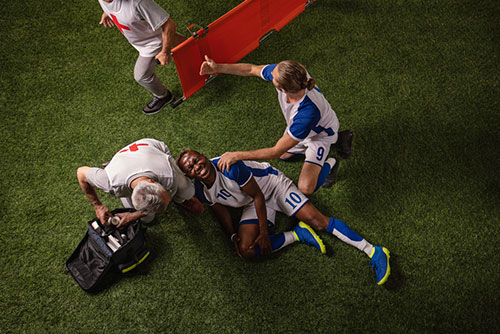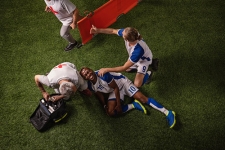
Tryouts are scheduled, State Games are played, and tournament championships and State Cups are vied for. While many of those events aren’t happening in typical fashion this year, soccer injuries are still a real concern for many players (and their parents). Luckily, there are steps you can take to prevent them. As the fall club season heats up for both boys and girls, it’s important to know what to be on the lookout for – especially since so many of these athletes have been sidelined for so long. Below is a shortlist of the most common injuries that can happen while playing the sport, and how to prevent them.
Heat Illnesses
Your child might get anything from heatstroke to heat cramps while practicing and playing outside in the heat. Heatstroke, which causes your body’s temperature to rise quickly, is very serious. It is caused by not staying hydrated in hot, humid weather. The sun and heat are especially strong at midday, and children who do not have the right conditioning are more at risk. Tightly fitting clothing might also increase the child’s risk.
Make sure that your child drinks lots of water, and have them avoid sugar and caffeine, as they can cause dehydration. For training or games longer than an hour, they should also have sports drinks available that contain electrolytes. In addition, it’s important to schedule breaks away from the heat and sun. If possible, your child should avoid training when the heat and sun are the strongest.
Ankle Sprains
Ankle sprains happen when one or more of your child’s ligaments get torn or stretched. The ligaments are what attach the bones to each other, and they work to stabilize the joints. Uneven ground accounts for 90 percent of ankle sprains during soccer. Sprains can also be caused when the foot is planted and the player suddenly changes direction.
To prevent ankle sprains, you should make sure that your child has well-fitting soccer cleats. If the ankle is susceptible, a rigid ankle brace might provide more support. The child should do ankle stability exercises, and other exercises, such as calf raises, single-leg balancing on stable surfaces, and single-leg forward hops can also be helpful. The child should control their posture, which means they will use their core muscles and stay low.
ACL Sprains
The anterior cruciate ligament (ACL) is a vital ligament in the knee. But while playing soccer, it can become torn or stretched. Female soccer players are especially susceptible to this type of injury, which might be caused by a blow to the front or side of the knee. Sudden changes in direction on the field can also be a cause, as can sudden slowdowns.
This injury can be prevented by helping your child strengthen their hip muscles. Squats are one way to do this. They can also do clamshell or fire hydrant exercises. Other steps to prevent ACL sprains are similar to those to prevent ankle sprains. For one, it is important for your child to wear soccer cleats that fit them properly. In addition, your child should use their core muscles and stay low on the soccer field.
Now that you know the causes of several common injuries and know how to prevent them, you can work with your child to have a fun, healthy experience while playing soccer. If, however, something goes awry on the soccer field, please know that the orthpaedists here at Prairie Orthopaedic & Plastic Surgery, PC. in Lincoln, Nebraska, are here to help treat orthopaedic related ailments and injuries (due to soccer or otherwise). Give us a call at or visit our website to schedule an appointment!

